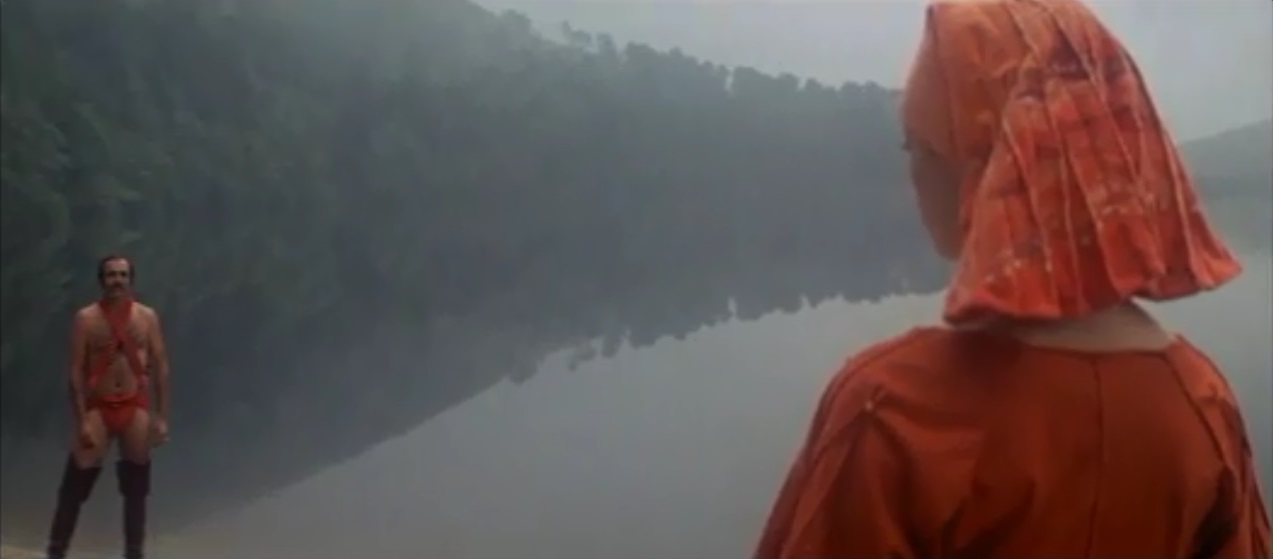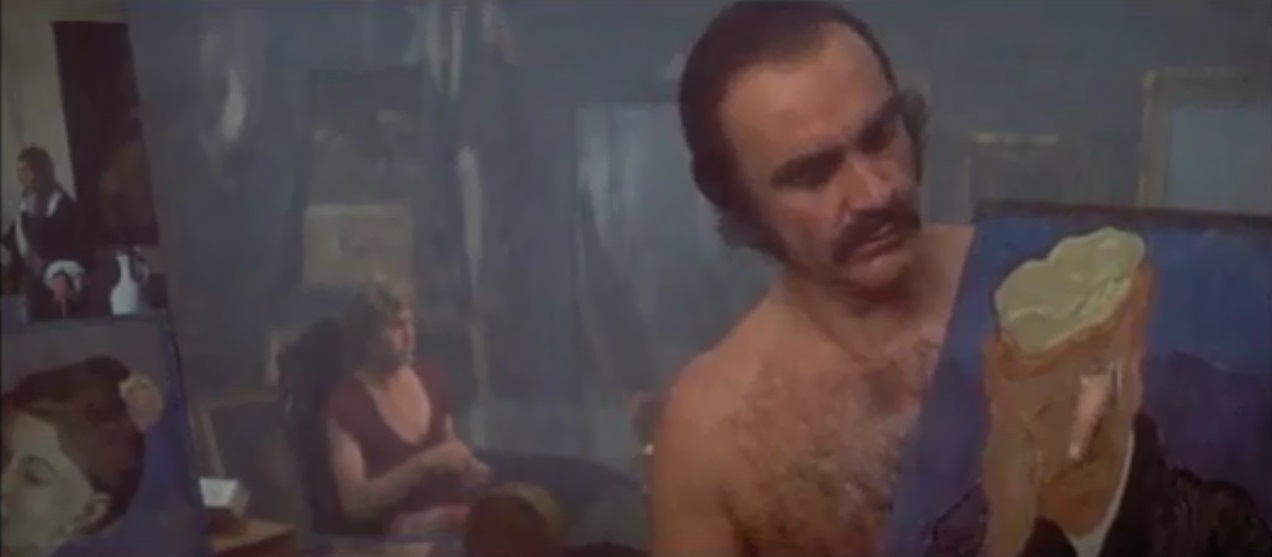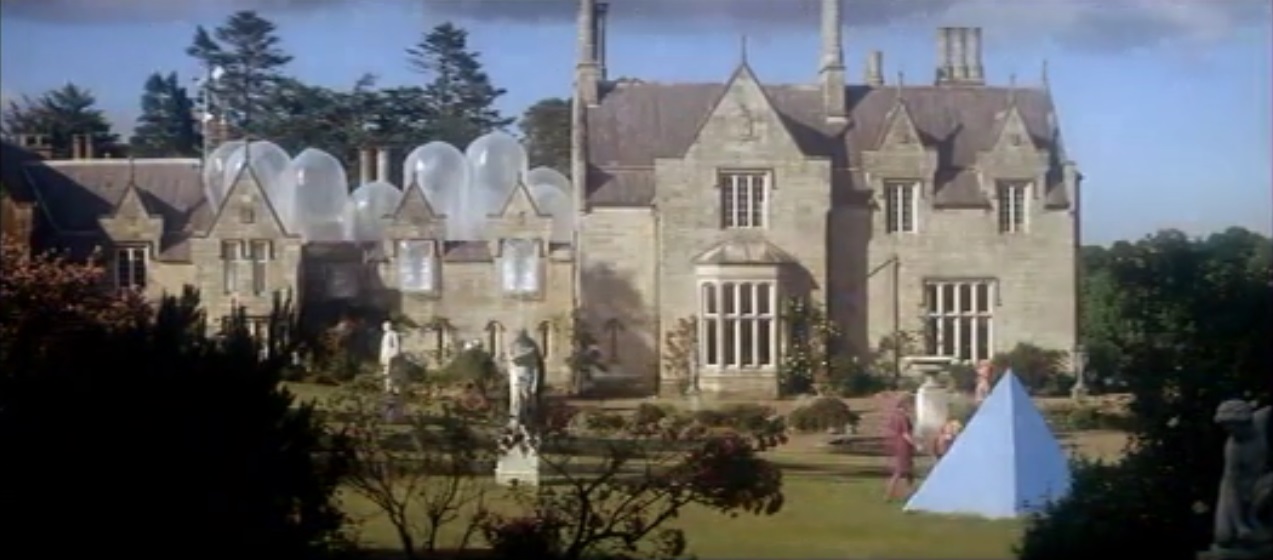Point
Blank
The beginning and
end of a partnership that transfers to corporate ownership (Multiplex Products
Company), the beginning and end of that.
Cf.
Byron Haskin’s I Walk Alone.
Hell in the Pacific
It should have
been perceived at once that this film is more than what reviewers term the
usual “fare” (it has something in common with Brook’s Lord of the Flies, for instance), and if
it had been released after Deliverance,
that might have happened.
Now
you have two actors of such capacity with heroic direction on island and sea,
with a fine score by Lalo Schifrin, and it has never received the attention
that is its due.
Mifune was “an Oriental stereotype”,
says Variety, and the New York Times looks down its nose.
East and West that never meet but rarely.
Leo the Last
The end of the
empire in a nameless London cul-de-sac, the best case for an improved social
order.
The inheriting
scion, an abstemious bird-watching pacifist, discovers by patient observation
that he is a slum landlord. He leads a rebellion on
Guy Fawkes Night that achieves what the Blitz could
not.
Jewison has the
same flickering eye at the periscope in The Russians Are Coming The Russians
Are Coming, Lear the feeding scene with smokers in Cold Turkey. The group enlightenment in a swimming pool is a prevalent
joke.
There is a right
wing to this fowl, led by the estate agent who collects the rents from the pimp
in the neighborhood.
The soundtrack is
replete with voiceover commentary, catchphrases, song lyrics, bits of verse and
conversation (cf. DeMille’s Unconquered). Suschitzky’s cinematography is made as wretched as
possible throughout, in advance of the time.
Leo feasts a poor
family like Scrooge at Christmas and kills the paterfamilias with kindness. The daughter is forced into prostitution, Leo hits upon
his plan.
The basis of the
metaphor and much of the film is Hitchcock’s Rear Window, this has
not been observed by critics, of whom the most interesting in his nonsensical
view has been Roger Greenspun of the New York
Times, “the esthetics of commitment... a taste for profitable
risk-taking”, and so forth.
The
cul-de-sac in Mackendrick’s The Ladykillers, the house guest in
Howard & Asquith’s Pygmalion, and the Guy Fawkes
children in Richardson’s a taste of honey (by way of T.S. Eliot),
have also gone unnoticed.
“A
stunning but simplistic political parable” (Time). “Precarious
fantasy” (Time Out Film Guide). “At
best silly, at worst pretentious allegory and unsuccessful social
comment” (Variety). “Infuriating
symbolic fantasy” (Halliwell’s Film Guide).
Deliverance
James
Dickey’s screenplay is a parlor trick of a sort, a transposition of Robbe-Grillet’s Le
Voyeur (but
cp. Anthony Mann’s The
Naked Spur
significantly), availing itself of at least the one complete model
to fabricate a comprehensive satire of Atlanta types and Georgians in general,
by way of finding their true character somewhere out behind the piney woods.
Its enormous
artificiality is theatrically graduated for structural compression, and this is
the key to Boorman’s remarkable technical accomplishment, the graduated
approach to the river that is derived from Renoir (The Southerner), who
got it from Griffith. That is to say, a complex
apparatus of setups and sound registration put together as photographic record
and location sound (regulated by focal range and ambience). In
effect, the presentation of Deliverance
in theaters was a signal triumph of cinema, a technical achievement executing a
poetic idea and transcending itself as evocation.
It’s a rare
thing to see a poet’s work onscreen. The
vertical structure Dickey builds on his originals imparts well-rounded freedom
to the actors, who give performances of almost evanescent subtlety, caught by
Boorman and Zsigmond with unfailing mastery.
The last encounter
with the mountain men is filmed in such a way as to suggest the possibility of
a bad dream, the previous one ends with the funeral procession from Dali &
Bu˝uel’s Un Chien
Andalou and Alan Bridges’ The
Shooting Party.
Zardoz

The great Stone
Head that hovers over savages on horseback, disgorging firearms unto them in
masses, bidding them to kill, is the sufficient image. A
satire of the so-called intelligentsia, the undoubted beauty of which, for it
is very beautifully filmed (Geoffrey Unsworth cinematography), puzzled the mind
of Halliwell’s Film Guide,
where it is described as a “pompous, boring fantasy for the so-called intelligentsia.” The central thread of the argument is from
Kubrick’s 2001: A Space Odyssey
as a close parodistic analysis, other material is
brought in from Schaffner’s Planet
of the Apes and Pal’s The Time
Machine and Dali & Bu˝uel’s Un
Chien Andalou (projected
crop report) and Truffaut’s Fahrenheit
451 (a flashback giving the title), even Levy’s Herostratus inside the Tabernacle, the crystalline structure that
rules the Eternals, one of whom raises up Exterminators to quell the Brutals of the Outlands, a conceit not far from
Godard’s Alphaville.
“No-one else wanted to run the
Outlands. He’s an artist! He does it with imagination.” Therein lies Enlightenment.
One of these
Exterminators gains entry to the Stone Head, expels the “artist”
and travels as a passenger to the paradisal Vortex whence it came, there the
Outlands are something of a mystery. His name is Zed,
the Britannic “Z”, he is played by Sean Connery, who in Tarzan’s Greatest Adventure (dir.
John Guillermin) refers to “that vaudeville act... Goering & Himmler.”
“Even
supposedly ‘intellectual’ film-makers such as Antonioni, Bergman,
and Fellini have succumbed occasionally to the occupational temptation of
anti-intellectualism as a means of escaping Hamlet-like from their own
passivity. But Boorman carries the self-hatred of the
intellectual to ridiculous extremes, and he fails to implicate the viewer
besides” (Andrew Sarris, Village
Voice). “A glittering cultural trash
pile” (Pauline Kael, The New Yorker).

The Stone Head
also figures in Byron Paul’s Lt. Robin Crusoe, U.S.N., and there
is an interesting parallel in Marc Daniels’ Planet Earth. “The world was dying, we took all that was good, and
made an oasis here.” The joke basis of this
future society with its subtly Egyptian flavor in the working costumes is
Shakespeare’s Love’s Labour’s Lost, not to mention the
fabled source in the Emerald City of Larry Semon and
Victor Fleming (and King Vidor). Menzies’ Things to Come suggests the fruitless
dichotomy of Apathetics and Renegades. Elio Petri undoubtedly recalls
the final “havoc in the garden of beauty” at the end of Todo modo. For the ending, cf.
Keaton in College (dir. James W.
Horne) or to be sure Dali & Bu˝uel’s Un Chien Andalou.
Amusing
references to the Bond films include the trapdoor slide from Gilbert’s You
Only Live Twice (visibly out of Welles’ The Lady from Shanghai)
and the projected “touch-teaching” sequence.
“Doesn’t
offer satisfying answers” (Nora Sayre, New York Times). “An exercise in self-indulgence” (Roger Ebert,
Chicago Sun-Times). “A brilliant premise
which unfortunately washes out in cinematic sound and fury” (Variety). “Cheap sci-fi flick” (Judith Crist, New York). “Pretentious sludge” (TV Guide). “Needs a road map simply to follow the plot and sort out its intended
parables” (Catholic News Service Media Review Office). “A mess of philosophical pottage” (Time Out
Film Guide).

Exorcist II
The Heretic
Boorman opens
with a flurry of images. The rustic church with its
slatted walls is an evocative reminder of the painter’s studio in Orson
Welles’ The Trial. There Father Lamont (Richard
Burton) is conducting an exorcism which resembles The Night of the Iguana (dir. John Huston).
The possessed woman incinerates herself, an image that only seems hard
to place. Now Regan (Linda Blair) is seen rehearsing
“The Lullaby of Broadway” from Gold Diggers of 1935 (dir. Busby Berkeley). Her therapy sessions with Dr. Tuskin
(Louise Fletcher) naturally suggest The Miracle Worker (dir. Arthur Penn).
It may be that Otto Preminger’s The Cardinal is cited
later, Regan on the rooftop briefly evokes Georges Franju’s Les Yeux sans Visage, and there is a distinct if deceptive
echo of Roy Ward Baker’s Quatermass and the Pit.
Exorcist II:
The Heretic was made after Zardoz, not before, and yet everyone seems to have
thought it was a shambles rather than a cryptogram of The Wizard of Oz. The two instances of self-immolation that occur reflect
the fiery exit of The Wicked Witch of the West. Father
Lamont’s pilgrimage, Dr. Tuskin’s trance
machine (which is nothing but Professor Marvel’s crystal ball), and the locusts
taking the place of the flying monkeys are all components of the cipher, which
pleasant as it is only provides the basis for an articulation of the material
that’s brilliant.
The construction
is meticulous throughout. The open hoke
of the trance machine is plainly defused by referring to Uri Geller as the
setup to a delightful little gag. The polar shift from
Iraq/Washington, D.C. to Ethiopia/New York City has the effect of dislocating
the narrative just enough to allow for the theme and variations. Little Regan’s Statue of Liberty play at the close
allays the locust attack. Louise Fletcher’s
uncanny resemblance to Ellen Burstyn in the last scene, combined with
Boorman’s dissolve on Regan possessed and “normal”,
almost suggests a Bu˝uelian switcheroo.
Critics nowadays
want nothing but characters they can “believe in” and stories they
can imagine for themselves over popcorn by the fire. Anything
more than that and our critics start to use words such as
“thought-provoking”, which are no help to audiences who laughed
themselves silly at Exorcist II: The Heretic (according to some reports). TV Guide takes a surprisingly charitable view,
calling it “no masterpiece.”
Excalibur
English
filmmakers can’t resist taking the piss out of certain overbearing American
science-fiction productions. The Day the Earth
Stood Still (dir. Robert Wise) gave us Devil Girl from Mars (dir.
David MacDonald) and Stranger from Venus (dir. Burt Balaban), Mighty Morphin Power Rangers provoked Teletubbies.
Here the
Arthurian legends are garbed in outfits sometimes resembling the critters in Quatermass
and the Pit (dir. Roy Ward Baker),
with music from The Ring of the Nibelungen
(and Orff). It would not be
too much to say that the result is undeniably bizarre, but for the audiences
that drank at the fount of Star Wars, not even brazen blarney was too
much—which is to say, it was filmed in Ireland, and then apparently taken
at face value by Variety and the Edinburgh U. Film Society.
The Emerald Forest
This is a Tarzan
film with Buster Crabbe, but resuming the whole
series. Knowledge has been drawn from Penn’s Little
Big Man, Donaldson’s The Bounty, Richardson’s The
Border, and Hamilton’s Force 10 from Navarone. The Sacred Stones are found in the river like Excalibur, Edith Wharton’s “Xingu”
comes to mind.
More than a
masterpiece, several times more, because it only says what we have always known
from Burroughs’ creation.
In the Amazonian
jungle, the Invisible People and the Fierce Ones and the Termite People, who
are building a dam.
Several critics
have faulted the faultless narrative, some the very fine stylization, a few the
overall dramatic tone. In a film as wildly enjoyable
as this, they were put off.
Hope and Glory
Neville Chamberlain
declares war, Dad joins up to do his bit like in the last one, only by the time
he’s finished officer training he’s too old to take a commission,
therefore he’s sent away from London to a base where he fights the Jerries with a typewriter and the rank of private.
His mate would
have married the wife only he didn’t have a job, now he’s on a
fiddle like most civilians, and taking her to hear Dame Myra Hess.
What with the
raids and assorted crises, Dad garners so much compassionate leave that
he’s assigned a post nearer home, “to fight the bloody war down
there.” Winston Churchill declares the end of
the beginning.
“Entirely
fictitious,” says the standard disclaimer.
Beyond Rangoon
You don’t
know about Beyond Rangoon, without you have seen a film by the name of The
Adventures of Huckleberry Finn. The critics most
assuredly hadn’t.
The General
Dublin’s
master burglar and thief, who did a deal with the Loyalists and was murdered by
the Republicans.
The fourth item
in this main structure is the Irish policeman, “the best policeman in the
world,” as Richard Boleslavsky says in Acting:
The First Six Lessons. “He never sleeps on
duty. He dreams wide awake. And
the gangster has little chance.”
A game of pairs,
“the general” and the policeman, the two factions, the wife and her
sister.
Scorsese is
instrumental in all this, Raging Bull for the hero (and the
cinematography), Goodfellas for much of the
dramatic construction.
The two main
robberies glancingly suggest Richardson’s the loneliness of the long
distance runner (the upstairs window) or perhaps Friedkin’s The
Brink’s Job, and Wyler’s How to
Steal a Million (Old Masters, the false alarm).
The majesty of
the law has not time to make itself known before the killing, a “military
necessity”.
The Tailor of Panama
It’s a
setup and punchline, if you like, but what a setup, what a punchline, and what
a middle range of subordinate materials cushions the devastating guffaw.
The opening
greatly resembles the setup of His Girl Friday. Hawks
has breathless Rosalind Russell about to be whisked off to Albany by Ralph
Bellamy, and catches her starry-eyed glance in one close-up that’s the
key to the whole business. Here, it’s the
opening shot of MI6’s new building on the Thames, too absurd for words.
The rest of the
scene is laid in Panama, a poor and corrupt nation latterly in possession of
the Canal ceded by President Carter, who is caricatured as Gen. Dusenbaker of the Marines, anxious to get it back. “You are the Canal,” an operative tells the
tailor’s wife, an American who works there.
The operative
inveigles information from the tailor, who gives it first on a point of pride
because the remnants or vestiges of resistance are sneered at, and then because
he needs the money. There is no information, because
there isn’t any “silent opposition”,
but the operative inveigles a small fortune out of Washington via
London, and the Americans get their air strike at least, before the
tailor’s wife gets it all called off.
The script by
several skilled hands is complicated, expressive, rapid and constantly quotable. Boorman’s direction is via Schlesinger in the
versatile all-encompassing medium shot and the New Wave vaudeville touches. There is a subtle complexity in all the acting, which is
partly put there by Boorman himself, having cast Pierce Brosnan,
for example, as the operative both for the Bond satire and for his resemblance
(deliberately evoked by Brosnan) to Fred MacMurray in Mitchell Leisen’s
Panama film, Swing High, Swing Low (and if this is purely fortuitous,
it’s a pure inspiration).
Boorman also has
a little echo of Deliverance on the water, as well as a long,
well-calculated joke on Casablanca, which is what Panama is, the tailor
tells the operative, “Casablanca without heroes.”
An elaborate
shot/reverse shot explains the operative’s girl in the embassy, as
she’s reflected in an ornate mirror beside him, with the young political
officer standing by the portrait of a lady on the embassy wall opposite.